This is my favorite pierogi dough recipe – soft, elastic, smells of butter and is easy to roll out. This is the best pierogi dough recipe you’ll find. Below I’m also sharing many tips on how to make the perfect pierogi and answer all the questions you could have.
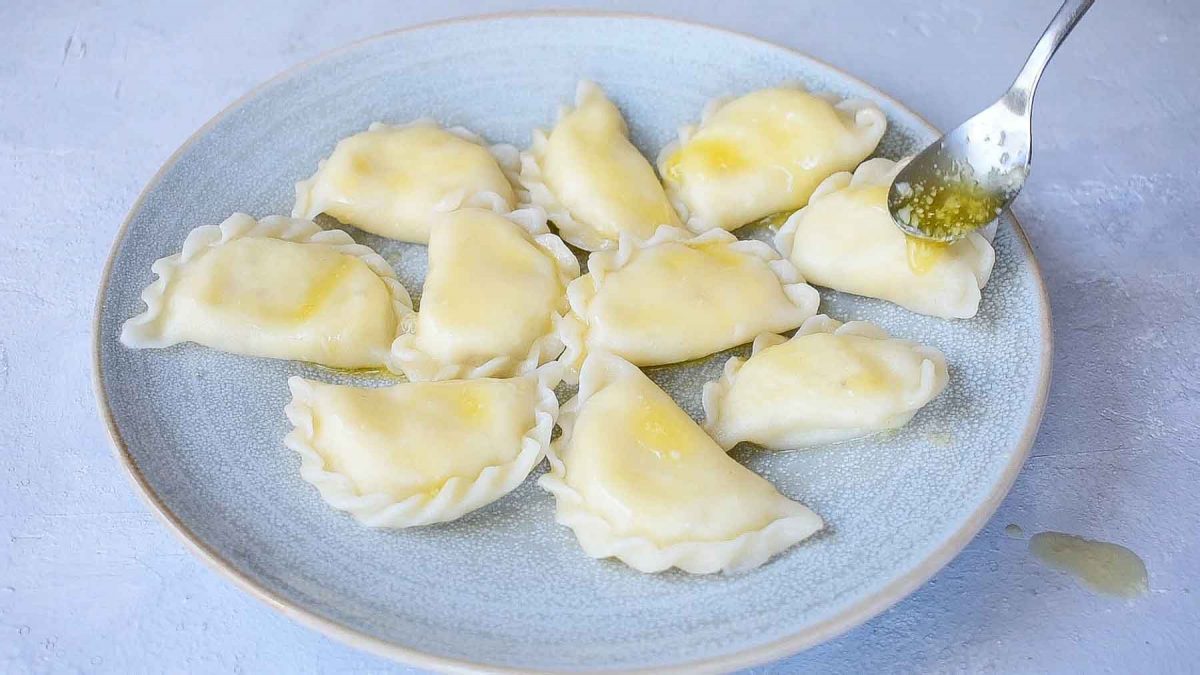
What are pierogi/pierogies?
Pierogi are Polish dumplings, made with unleavened dough and filled with sweet or savory fillings. They are boiled and then sometimes additionally pan-fried.
Pierogi in Poland:
Pierogi are one of the most popular Polish dishes. They are served as a main dish or as a side dish. The most popular pierogi are potato and cheese pierogi, sauerkraut and mushroom pierogi, and pierogi with meat filling (at least in the region where I’m coming from). In summer sweet pierogi (filled with fruits, like strawberries and blueberries) are popular. The flavor combinations are countless.
In Poland you can find small restaurants, where only pierogi are being served, they are filled with many different fillings. Such a restaurant is called ‘pierogarnia’.
Pierogi, Pierogies or Perogies?
Although the word ‘pierogies’ is popularized in English-speaking countries, it is not the true name of these Polish dumplings. The correct name is: singular – 1 pieróg and plural – pierogi. There are no other terms to name it.
What is the difference between pierogi and ravioli:
Ravioli are Italian dumplings, that are wrapped in pasta dough (this dough must contain eggs and is more rich and tough). Italian fillings also differ from traditional pierogi fillings.
Top tips for making the perfect pierogi dough:
- Traditional pierogi dough is easy to make without a recipe (I think no Polish grandmother makes it with a recipe, at least both my grandmothers don’t). The exact recipe is not important here, if the dough is too dry, you need to add some water, if too wet – a little bit of flour. However, it is worth having your favorite recipe and a kitchen scale on hand – the preparation goes much faster, the ingredients are added into a bowl and kneaded together, you don’t need to add additional water or flour.
- One of the most important things is, that the dough is well-kneaded!
- After kneading the dough, let it rest. You can see on my video how much softer and pliable the dough is after it has rested.
- Best water temperature – very hot but not boiling.
- Add some fat – it can be butter (more flavor) or oil.
- Don’t add eggs to the dough (more on that below).
- Dough to filling ratio: it’s very important, but it’s also a matter of taste. I like it when my dough is not very thin but also not very thick. I like to stuff my pierogi with lots of filling but I also like to taste the dough. Experiment what works best for you.
Easy pierogi dough ingredients:
- The best flour to make pierogi – I’m using all-purpose flour.
- Water – it’s important to add hot water to the dough. It makes the dough soft and pliable. You should warm the water with butter until they are very hot, but not boiling (temperature around 80-90 °C / 176-194 °F, that is when the water starts to move and steam). Too hot water will make the dough a little bit more chewy and sticky. Cold water will make the dough harder to roll out and it will be more difficult to shape the pierogi.
- Fat – you could make the dough without it, but it really makes the dough perfect. I’m using butter for its taste but any vegetable oil will also work.
- Salt – also the dough should be seasoned, not only the filling.
- I’ve seen some recipes that call for sour cream. Personally, I’ve never heard of such pierogi dough ingredient and don’t know anyone who is making pierogi with it (at least in Poland). I think it’s more an American or Russian/Ukrainian ingredient. Nowadays though, many home cooks experiment with the ingredients. Authentic Polish pierogi dough recipe call just for flour, water, salt, and optionally some fat and an egg.
Pierogi dough with egg or no egg:
There are two ways of making the pierogi dough – with or without an egg. Many Polish home cooks are arguing, which way is the best.
For me, the perfect pierogi dough is made without the egg. The dough with eggs is a bit tougher in my opinion, but the difference with a well-kneaded dough is not that huge (but there is a difference).
The second reason why I don’t add an egg is that it’s more hygienic – having a small child at home, I usually make a lot of pierogi in one batch, but making a lot of breaks in between. I do not have to worry about washing my hands thoroughly all the time, taking care if the table is well cleaned and watching out if my daughter is eating a dough with a raw egg.
By the way, you should try making pierogi with your kids. Rolling out the dough, cutting out rounds, shaping the pierogi – I think it’s a fascinating activity for every child!
Since this pierogi dough is made without eggs it is suitable for vegetarian diet, vegan diet or dairy-free diet (swap the butter for vegetable oil), or egg-free diet.
What equipment do you need:
- I love making my pierogi dough in my Kitchen Aid but you can also make it by hand. You’ll need to knead the dough for about 10 mins. A food processor can also be used (fitted with the dough blade), but I prefer the stand mixer.
- A rolling pin (or alternatively a wine bottle!). For rolling out the dough you can use a pasta maker (I’m sometimes using my Kitchen Aid pasta attachment). I find that it’s equally easy to roll out the dough by hand and with the pasta maker. Pierogi dough is much more pliable and soft in comparison to pasta dough, which makes it easier to roll out by hand.
- Pierogi cutter / pastry cutter / a cup (preferably with sharp edges). I prefer to use a real pierogi cutter or a pastry cutter – it’s easier to cut out rounds. A regular glass/cup can also be used but I find cutting out round a little bit harder as its edges are more thick and blunt. It would be better to use a glass that has thin, sharp edges if you don’t have a pierogi cutter (both my grandmas are using a regular glass though ;)).
- A pot to cook the pierogi (obviously) and a slotted spoon.
- There are pierogi maker press or pierogi molds available if you search online. I haven’t personally tried them out. Feel free to let me know if there are any that you really like!
How to make pierogi dough – step by step:
STEP 1: Add flour and salt to a large bowl.
STEP 2: Add hot water with butter.
STEP 3: Mix with a wooden spoon until roughly combined.
Would you like to save this?
STEP 4: Knead the dough until smooth and soft.
STEP 5: Prepare the filling.
STEP 6: Roll out the dough and cut out the rounds.
STEP 7: Place the filling on the round.
STEP 8: Shape the pierogi. Ready to be cooked!
How to measure the flour:
In the recipe card below, I provided all possible measurements for the pierogi dough – by volume and by weight. I’m always using a kitchen scale to make my pierogi (and generally to develop the recipes on my website). If you’re weighing your ingredients on a scale your results will be very consistent and the same as mine. It’s really easier, quicker and a kitchen scale is super cheap!
If you’re measuring the flour with measuring cups there is a possibility that you will add more or less flour than I did. You need to check the consistency of the dough and add more flour if it’s too wet and more water if it’s too dry and too tough.
Measuring the flour with measuring cups is unfortunately very inaccurate. 1 US cup of flour can weigh from 120g-140g, depending on how you fill the cup. 20g is a little over 2 tablespoons of flour, so when this recipe calls for 4 cups of flour, you could have added 8 tablespoons more flour which is 1/2 cup! For measuring flour I’m spooning the flour into the measuring cup with a tablespoon and not scooping it with the cup. Level the flour with the back of the knife and don’t tap the cup or press down the flour. Read this article for more information on how to measure flour.
1 US cup is 240 ml. An European cup is 250 ml!
How to roll out the dough with a pasta maker:
Pierogi dough can also be rolled out using a pasta machine. I have a Kitchen Aid pasta roller attachment. I roll out the dough on setting 4. According to the manufacturer’s instructions you need to roll out the dough on each setting until you get to the setting 4. I’m not doing this, pierogi dough without an egg is easier to roll out than an egg dough or pasta dough. To make it possible, the dough must be well sprinkled with flour, at room temperature, slightly rolled out with a rolling pin (to a thickness of approx. ¾ cm / ½ inch) and smooth (otherwise will tear).
How to store pierogi:
To ensure that the cooked pierogi don‘t stick to each other, brush them lightly with melted butter or oil. Store in a tightly-closed container in the fridge for about 2 days. On the next day, it‘s best to pan-fry them with butter until golden.
Freshly cooked pierogi taste best for me, so I usually do this: I prepare only the amount of dumplings that we are going to eat on a given day (about 14 per person, my pierogi are rather small, see the video for the reference). I wrap the rest of the dough tightly in plastic foil and put it in the fridge. I place the rest of the filling (or make filling balls from all of the filling) and also tightly wrap in plastic foil and put in the fridge. On the next day (or even on the third day) I’m preparing the rest of the pierogi.
If I have more time and I’m making more pierogi in one batch, I freeze them or pan-fry with butter the next day.
After removing the dough from the fridge, it is good to slightly warm it up (leave it for about 15-30 minutes on the counter), it will be more elastic (this is optional). The next day the dough can look a little gray in color, but we don‘t mind that.
Freezing tips:
- Cooked pierogi: Place the pierogi apart on a tray, sprinkled well with flour. Freeze until solid. Transfer to containers on plastic bags. Cook like fresh pierogi but take them out once they float on the water surface.
- Uncooked pierogi: Note that not boiled raw pierogi are more likely to crack in a freezer than cooked pierogi. I most often freeze raw pierogi though. Place the pierogi on a tray / wooden board sprinkled well with flour (important, dumplings can easily stick to the tray and tear). Arrange the dumplings so that they do not touch each other. When frozen, transfer them into containers or plastic bags. I cook frozen dumplings just like fresh ones, with the difference that you can cook a smaller amount of them at a time, I cook max. 7-8 frozen pierogi at once (and about 10-12 fresh). When you drop too many frozen pierogi at once it will lower the temperature of the water too much and they will burst.
Store-bought frozen pierogi:
I’ve never eaten store-bought frozen pierogi that tasted amazing (maybe I’m just spoiled with homemade pierogi!). In terms of taste, some of them were not that bad, but for me, the dough is always too thick. This is not surprising since these pierogi are not made by hand. The dough manufactured in a factory need to be thicker so it won’t easily break and can be filled by a machine. Homemade pierogi all the way!
FAQ:
Knead the dough well then let it rest before rolling it out. A good recipe is also important – add butter and hot (but not boiling) water to the dough.
Toss the hot, freshly cooked pierogi with butter or oil until coated on all sides.
You can freeze cooked pierogi or uncooked pierogi. See the instructions above.
There’s no need to do that. You can throw frozen pierogi direct into boiling water.
I like to keep it simple and just pour melted butter over them. Other options are: sauteed/caramelized onions, pan-fried bacon, chopped parsley. Sweet pierogi are often served with sweetened heavy cream/sour cream.
Here you’ll find all my pierogi sauces and toppings ideas.
Yes! You can wrap the filling in shortbread pastry and bake until golden. This kind of pierogi is not that popular but in some regions, people are making baked pierogi.
Your dough was probably not evenly rolled out. Thicker pierogi will be a bit bigger, also when you fill them with more filling. If the dough is of the same thickness you can cook the small and big pierogi the same way.
Cut it into thick strips and use as pasta eg with soup.
It’s probably not well-kneaded, not rested or you’ve used cold water. It’s also possible that you’ve added too much flour – add more water until the dough is smooth and soft.
It really depends on your preferences. I really dislike dough that is rolled out too thick. When the dough is thinly rolled out it literally melts in your mouth after you cook the pierogi.
It will take a minimum of 5 minutes by hand and about 3 minutes in a stand mixer. It can take longer or shorter. You need to pay attention to the dough’ consistency – it should be smooth and soft (check out the video to see the consistency of the dough). It will be even softer when it’s rested.
The dough can be too elastic and shrink as you try to roll it out when it’s not rested. Make sure to rest the dough for about 20-30 minutes, then it should be easy to roll out. This is caused by gluten that is in every type of wheat flour.
Filling recipes:
I have a separate post, where I talk about all the traditional and modern pierogi filling ideas.
Here are the written recipes:
- authentic potato and cheese pierogi (pierogi ruskie) – with potato, twaróg cheese, and onion filling
- potato and cheese pierogi the American way (cheddar pierogi)
- sauerkraut and mushroom pierogi
- spinach and feta pink pierogi (basic pierogi dough is colored with beetroot juice!) with potatoes, onion, feta cheese, and spinach filling
- vegan/vegetarian pierogi with spicy lentil and sun-dried potato filling
- uszka (‘little ears’) pierogi – porcini (wild mushroom) filled mini pierogi for Christmas Eve Borscht
- sweet cheese pierogi
The best pierogi dough recipe + how to make perfect pierogi
Ingredients
- 4 cups flour 500g / 17.5-oz, spoon and leveled, all-purpose flour
- 1 cup + 2.5 Tbsp water 280g / 280ml / 10-oz (to weight on a scale)
- 3 tablespoons butter 1.4 oz/40g, or vegetable oil
- 1 teaspoon salt
Would you like to save this?
Instructions
→ Make the dough:
- Add the flour and salt into a large bowl, mix together.
- In a small saucepan, warm the water with butter until they are very hot, but not boiling (temperature should be around 80-85 °C / 176-185 °F, that is when the water starts to move and steam).
- Pour hot water with butter into the bowl with flour, mix with a wooden spoon until roughly combined.
- Knead the dough using your hands or with a stand mixer fitted with a hook attachment, for about 5 minutes. A food processor can also be used (fitted with the dough blade). The dough should be smooth, soft, and elastic, it shouldn’t stick to your hands. When you follow the recipe (especially if you weigh the ingredients, instead of using measuring cups), the dough should be perfect, but if for some reason it’s not, add some water if it’s too dry, or a little bit of flour if it’s too wet. If the dough already forms a ball, is relatively smooth, but still tough, it means that it’s not ready, it must be further kneaded until soft and elastic (after resting time it will be even softer).
- Wrap the kneaded dough in plastic foil (so it doesn’t dry out), leave to rest for about 30 minutes (it will be easy to roll out).
→ Rolling out, stuffing and shaping the pierogi:
- Divide the dough into 4 parts.
- Onto a lightly floured surface, roll out thinly the first piece of the dough, to a thickness of approx. 2 mm / 1/16 inch. If the dough is hard to roll out, set it aside for about 5-10 minutes to rest.
- Use a cup or a pierogi/pastry cutter to cut out rounds. Place one ball of filling / 1 teaspoon of filling on each round.
- Gather scraps, cover with plastic wrap and set aside.
- Fold the dough over the filling to create a half-moon shape. Press edges together, sealing and crimping with your fingers. Do not leave any gaps or pierogi may open during cooking.
- Place the pierogi apart on a towel lightly sprinkled with flour (this is important, they can stick to the board), cover loosely with a kitchen cloth so that they don‘t dry out.
- Repeat with the remaining dough.
-> Cook the pierogi:
- Bring a large pot of salted water to a boil.
- Cook the pierogi in batches (for a 21 cm /8-inch pot I cook about 10-12 dumplings at a time). When they float to the water surface cook them for 1-2 minutes, then remove from the water with a slotted spoon. The cooking time will depend on the thickness of the dough.
- Drain well and transfer onto a plate. Serve warm, pour over some melted butter.
- Enjoy!
Notes
To ensure that the cooked pierogi don‘t stick to each other, brush them lightly with melted butter or oil. Store in a tightly-closed container in the fridge for about 2 days. On the next day, it‘s best to pan-fry them with butter until golden.
Freshly cooked pierogi taste best, so I usually do this: I prepare only the amount of pierogi that we are going to eat on a given day (about 14 per person). I wrap the rest of the dough tightly in plastic foil and put it in the fridge. I place the rest of the filling (or make filling balls from all of the filling) and also tightly wrap in plastic foil and put in the fridge. On the next day (or even on the third day) I’m preparing the rest of the pierogi. If I have more time and I’m making more pierogi in one batch, I freeze them or pan-fry then with butter the next day.
After removing the dough from the fridge, it is good to slightly warm it up (leave it for about 15-30 minutes on the counter), it will be more elastic (this is optional). The next day the dough will be a little gray in color, but we don‘t mind that. – How to freeze pierogi: Cooked pierogi: Place the pierogi apart on a tray that is sprinkled well with flour. Freeze until solid. Transfer to containers on plastic bags. Cook like fresh pierogi but take them out once they float to the water surface. Uncooked pierogi: Note that not boiled raw pierogi are more likely to crack in a freezer than cooked pierogi. I most often freeze raw pierogi though. Place the pierogi on a tray / wooden board sprinkled well with flour (important, dumplings can easily stick to the tray and tear). Arrange the dumplings so that they do not touch each other. When frozen, transfer them into containers or plastic bags. I cook frozen dumplings just like fresh ones, with the difference that you can cook a smaller amount of them at a time, I cook max. 7-8 frozen pierogi at once (and about 10-12 fresh). When you drop too many frozen pierogi at once it will lower the temperature of the water too much and they will burst. – Rolling out with pasta machine: I have a Kitchen Aid pasta roller attachment. I roll out the dough on setting 4. According to the manufacturer’s instructions you need to roll out the dough on each setting until you get to the setting 4. I’m not doing this, pierogi dough without an egg is easier to roll out than an egg dough or pasta dough. To make it possible, the dough must be well sprinkled with flour, at room temperature, slightly rolled out with a rolling pin (to a thickness of approx. ¾ cm / ½ inch). and smooth (otherwise will tear). – 1 cup is 240 ml. – The amount of pierogi: based on the feedback that I got from readers, the amount of pierogi you’ll get from this recipe can vary greatly! My pierogi are rather small and I like to pack them with a lot of filling, that’s why I got 100 pierogi from this recipe. This may be different for you and you can get only half of this amount.
Did you make this recipe? RATE THE RECIPE or tell me in the COMMENTS how you liked it! You can also add a photo of your dish. It would make me very happy and will help other readers. Thank you!!


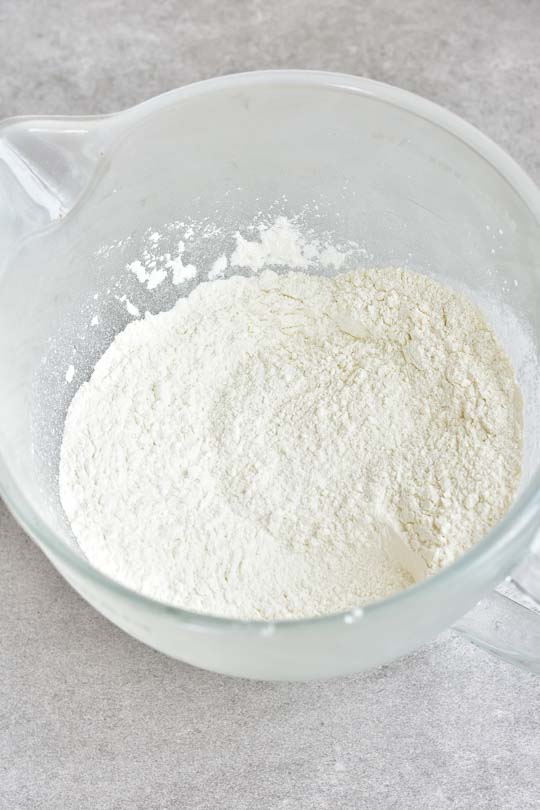
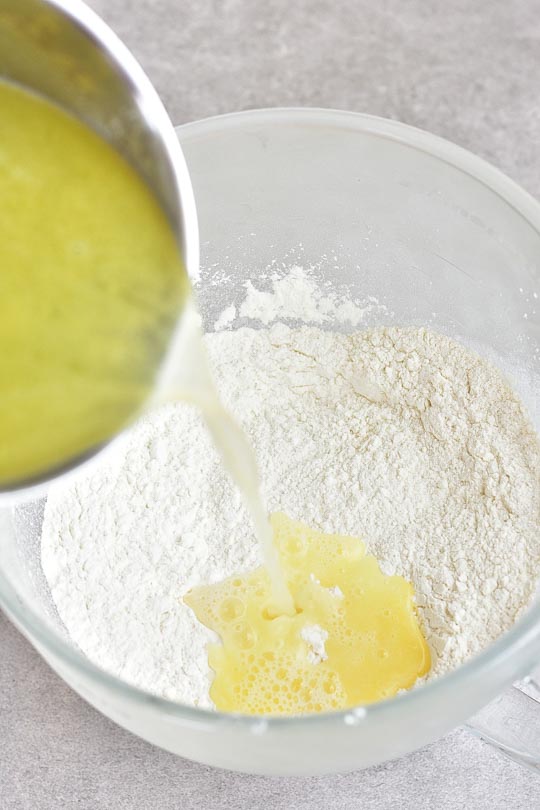


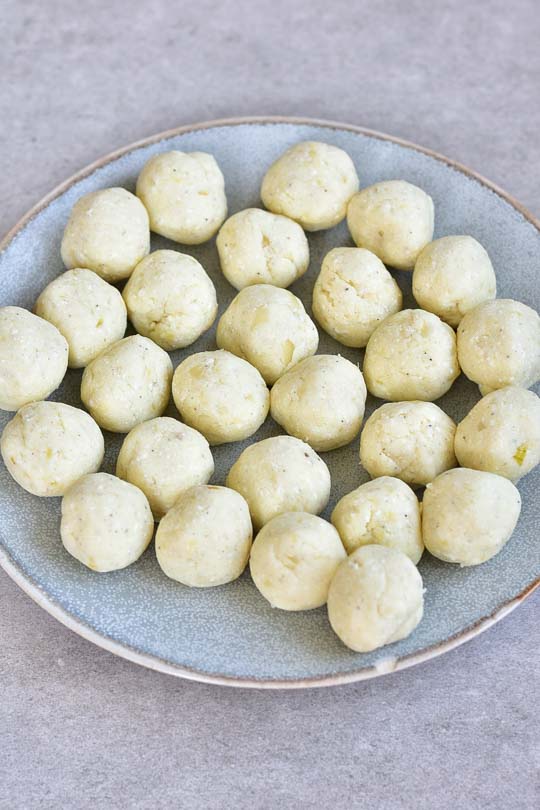
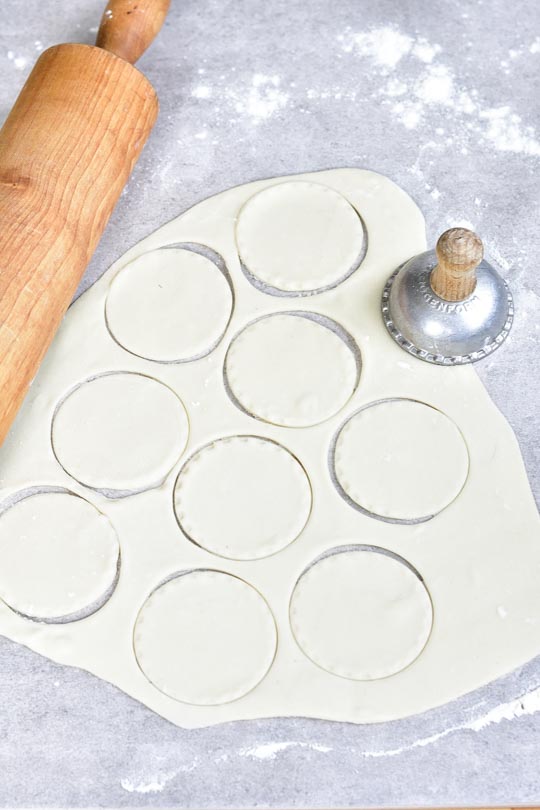
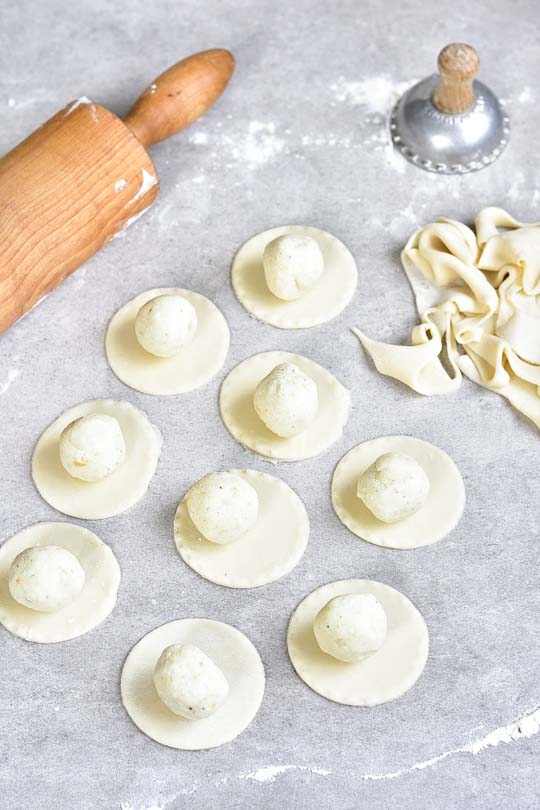
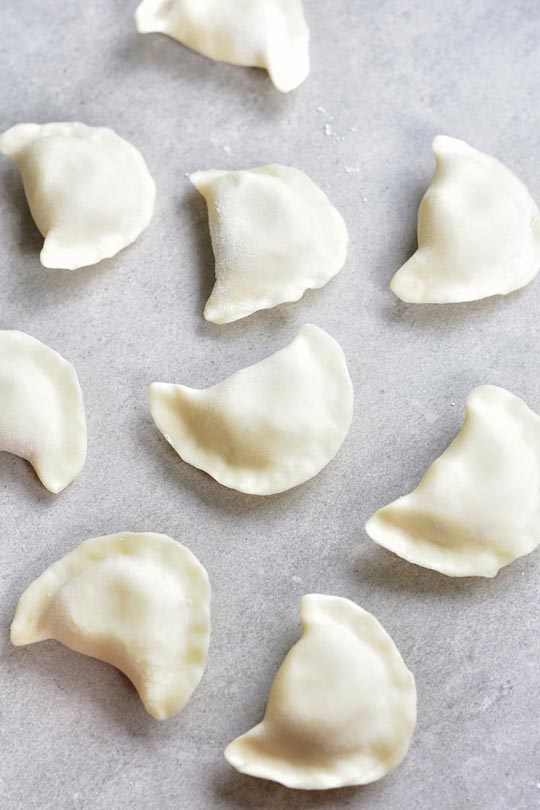
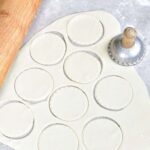

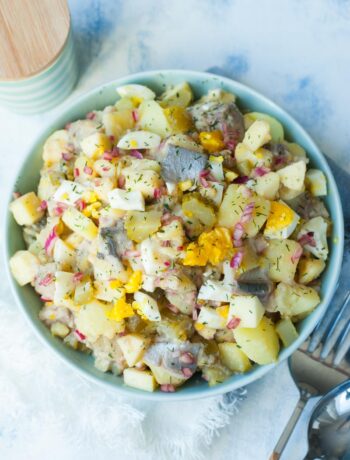
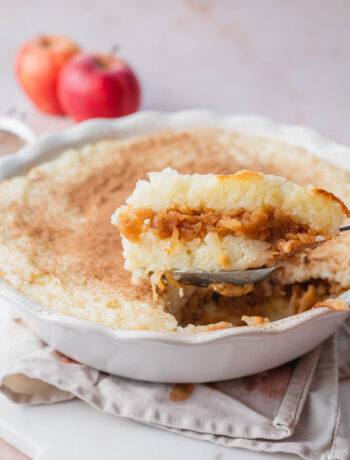
403 Comments
Adrian
25 October 2020 at 17:42This is the first time I made pirohi dough. I agree, this is the best recipe! It was so easy to roll out. My Baba would be so proud of me. Thank you so very much. Now I will carry on the tradition.
Grace
19 October 2020 at 14:38This recipe is amazing! It was so easy to follow, and truly was probably the best dough I’ve ever produced. I’d tried another dough recipe previously that had egg in it and it was kind of a disaster- this will definitely be my go to, and I can see myself adapting it for other types of dumplings!
Only thing I would say is this: as a novice dough-maker, determining what ‘tough’ meant once my dough ball was smooth was difficult. I probably should’ve kneeded the dough for longer so it didn’t spring back as much when rolling out- but that’s probably just a learning curve thing.
Bren
14 October 2020 at 21:34I had to write, I followed the recipe exactly, and OMG these are the best perogies I have ever tasted… I have used many recipes using sour cream, this one is the BOMB!! I will never use another recipe again for perogies… Thank you so much for sharing this!! The dough was sooooooo easy to work with compared to the other times I have made perogies!!
Aleksandra
15 October 2020 at 05:41I’m happy to hear that, thank you for letting me know and for the photo 🙂
karena
29 September 2020 at 22:01I have never made perogies before (eaten plenty though) and am new to dough making (I’m ways slightly nervous as to how the dough will turn out, always afraid of over kneading as I prefer to make my doughs by hand). I weighed out all the ingredients and I must say the recipe is perfect. The dough was absolutely beautiful and silky. There are several different perogi dough recipes out there using sour cream and/or eggs. This recipe was simple and traditional.Thank you for sharing!!
Aleksandra
30 September 2020 at 07:05I’m happy it turned out good for you! thank you for letting me know
Regina
3 October 2020 at 15:01This recipe worked out great for my German Maultaschen! My questions is can you make regular noodles out of this dough?
Aleksandra
3 October 2020 at 15:59Good to know! As for the noodles – not really, pasta dough is rich in eggs and here there aren’t any.
E. Zbaraschuk
26 August 2020 at 01:36As someone who:
-has a Ukrainian grandfather
-lives in a community with many skilled perogy-makers
-has made many different perogy recipes, including variations such as adding eggs, instant potato flakes, or sour cream
I can confirm that this IS the best pierogi dough recipe out there.
At first, I wasn’t sure if it would work. The dough was a lot tougher than other recipes I’ve used in the past. It was too tough to easily roll out by hand, likely because I used measuring cups instead of a scale. That wasn’t the end of the world though, as using a pasta roller was WAY faster. (I used setting 6 or 7 instead of 4).
My first perogy impressed me. The dough was tender and nicely flavoured. That said, my test for a truly good recipe is whether the perogies made at the end – with dough that has been rerolled 3-4 times – remain as tender as the first.
This recipe passed my test with flying colours. There was virtually no difference between the first and last perogies.
For anyone hunting down a great recipe, this is it! Now I can end my search for the perfect perogy and spend more time actually eating them!
Aleksandra
26 August 2020 at 05:14wow! it’s really wonderful to wake up and read such a fantastic review, so I thank you, too! 🙂
Jerry Gollaher
12 September 2020 at 19:16I have a question ? I do not claim to be a cook. I just fiddle around. Every time I make Pierogi dough, I have the same problem ! After rolling out the dough, and cutting the dough with a 3 1/2 ” or 4″ cookie cuter, the circle of dough, shrinks , making a smaller dough circle. Is this normal ?
If not, what can I do to solve this problem ?
Aleksandra
13 September 2020 at 06:04the dough should be well-rested (this is the main reason why the dough shrinks) and also try to sprinkle it more with flour while rolling it out, this should help!
Stacie
12 October 2020 at 15:15I would like to make a potato, cheddar, bacon kind, could I use bacon grease/fat instead of butter in the dough for more of the delicious bacon flavor? And if so, would I use the same amount as if it were butter or oil? Yes, we Canadians love our bacon!
Aleksandra
12 October 2020 at 15:22I haven’t tried that myself, but I can not see why not! I know it works with butter, vegetable oil, and as some readers reported even with vegan butter, so why not bacon grease! I would use the same amount as butter. Let us know how it worked out for you!
Olga
24 August 2020 at 23:01I tried your recipe and i must say the dough is perfect. I used farmers cheese for my filling. ty so so much.
Aleksandra
25 August 2020 at 05:12thanks for letting me know, you’re welcome!
zachary
21 August 2020 at 17:08very good and deeeelicious! really just as good as my moms when i was a kid . thanks!
Aleksandra
21 August 2020 at 17:33happy to hear that! you’re welcome!
Deb
19 August 2020 at 02:50My mom was the pierogie maker in the family. Her dough was like velvet, perfect but the recipe was in her head. So I’ve been looking for recipes, I’ve tried a couple, but always disappointed, way too tough. UNTIL I TRIED YOURS!! The dough was perfect, absolutely perfect and I have to say, shhhhh… better than my Mom’s. I made them bigger than yours, so I got 55 out of one batch. I had more filling so I made another half batch of dough. Weighing the ingredients is the bomb, the full or half recipe turned out perfect. Thank you so much, This is my pierogie recipe!!!
Aleksandra
19 August 2020 at 06:08I’m happy to hear that, Deb. Thanks for letting me know 🙂
Charlie
24 July 2020 at 16:11I just came across this dough recipe and its so similar to an asian dumpling dough except you add the butter. Question? Is the dough really rolled to a half inch thickness? I ask because it looks so much thinner in your video. Thank you.
Aleksandra
24 July 2020 at 19:47No, you need to roll out the dough quite thin, it should be about 2 mm / 1/16 inch thick (if you’re rolling it out by hand). I think you’re confusing it with the part when I’m describing how to roll out the dough using a pasta maker – first, roll it out quite thick, like 1/2 of an inch (by hand), and then even thinner using a pasta maker. The dough should be as thin as in the video. I think it’s similar to Asian dumpling dough 🙂
Charlie
12 August 2020 at 13:52Thanks. I like to read the entire recipe and notes before I try it so I confused myself about the half inch. So I made the dough and it definitely is a more tender lighter dough. I had a lovely and well rested smooth dough but rolling it out was a challenge as I had to keep resting it because it just wanted to spring back. The dough also sprang back after I cut the 3 inch circles which made it difficult to form the pierogi but I did manage. After boiling I found they had a slightly sticky surface which made it difficult to put them all in a dish without sticking. Tossing in butter helped but I like to pile them up in a dish until I am ready to fry them. Not sure where I went wrong here but I will say the texture of the cooked dough is lovely and soft.
Aleksandra
12 August 2020 at 14:29I think the water could have been too hot, if it’s too hot the dough gets kind of sticky, just like you described. I would also sprinkle the dough with more flour while rolling it out if it springs back too much (this should help if the water was the right temperature). Hope this helps!
Charlie
12 August 2020 at 15:16Thanks. Will try it. It was in between the range you suggest in the recipe.
Katherine
28 September 2020 at 16:17What do you mean by the water being too hot? The water added to the dough or the water you boil the pierogi in?
Aleksandra
28 September 2020 at 16:34the water you add to the dough
Vanessa
20 July 2020 at 00:35Hi.
My mum is from wroclaw and has moved to the uk when i was born! She would like to know where she can purchase the metal pierogi cutter with the wooden handle. Oh my question do you have a receipe for pierogi with pieczarki z cebula! Thankyou
Aleksandra
20 July 2020 at 05:21Hi Vanessa, I got this pierogi cutter from my mother in law and I think it’s about 50 years old (!), so, unfortunately, I can’t help with that. As for the pierogi recipe, I would just sautee the mushrooms with lots of onion and garlic and season maybe with thyme, you can also add some lemon juice at the end of cooking. Then chop it finely by hand or in a food processor (the method is similar to this recipe for mushroom deviled eggs https://www.everyday-delicious.com/mushroom-deviled-eggs/ but you need to omit the eggs and mayo). Hope this helps!
C
13 July 2020 at 03:22Definitely my new go-to recipe, wouldn’t change a thing(:
MARY
13 June 2020 at 23:24Thank you! I have wanted to make pierogies for years. This is my first try. I had some leftover fresh mashed potatoes and threw in shredded cheddar cheese together with onion powder and fresh grown dried parsley – so the inside was delicious. But your dough is absolute perfection! Thank you. I’m impressed they all came out wonderful. I finally did it! Thanks to your perfect recipe, directions, measurements. I greatly appreciate your share. I also appreciate all the 5 stars as they gave me the confidence to try. Oh, and I only made 1/4 the batch and it made about 13-14 mini/small pierogies. I roll all the dough at once, cut with a crimped round pretty cookie cutter, then I roll even thinner. They get flaky. I’ve made them twice in 2 weeks. Happiness.
Shippy
5 June 2020 at 16:53I used 1/2 white flour and 1/2 Kamut flour and they turned out amazing. thanks for all the tips these were the best perogies I ever made..!!!!
Bella
31 May 2020 at 15:22It’s been years since I made pierogi dough, and rather than flipping through my recipes in search of my old recipe I decided to give this a try. I followed the measurements to a T and the dough was absolutely perfect. thank you!!
Barbara
14 May 2020 at 00:21I was so happy to finally find the best dough recipe ever. I first made a batch and did not mix with water and butter in the bowl, I just used the bread hook. The dough did not form together, but it was a little tough. I did another batch and did everything you did and it came out perfect. It was soft and so easy to roll out and I just loved that you used your kitchen aid and the pasta marker to roll the dough out. What a time saver. I made potato and cheese and mushrooms with sauerkraut . I boiled them all up and then kept some aside and the rest I floured and put in the freezer. Thank you for being a life saver. I will be making Pierogis a whole lot more.
Gwen Curnow
13 May 2020 at 20:46Thank you! First time ever making pierogi and the turned out just perfect! I made a double batch and froze them fresh. They froze really well, with zero cracking and when recooked they are just as perfect as fresh. Love this recipe! Simple and easy and awesome!
Nicole
1 May 2020 at 03:15I made these and the dough turned out perfect.
I boiled mine for approximately 4 minutes altogether. The thickness suggested and 3 inch diameter with a heaping teaspoon of filling this time was sufficient.
My bobcia would be proud!
Dziękuję Ci !
Aleksandra
1 May 2020 at 05:48nie ma za co (you’re welcome) 🙂
Reza
12 April 2020 at 10:25Dear Aleksandra
First of all I would like to thank you to provide such a precise Pierogi recipe . I have tried once when I was in trip to Krakow and today I want to make as per your provided recipe The only question I have is for how long the dumplings should be in boiled water? I saw that you mentioned 2 minutes after they float on water surface. Do you mean first they sink for some minutes and then they float? If yes how much is the total boiling time
Thanks a lot Alexandra
Regards
Reza
Aleksandra
12 April 2020 at 12:30Yes, after you add the pierogi to the pot they will fall at the bottom of the pot and then will float to the surface. You need to cook them for 2 minutes counting from this moment! I can not give you total cooking time because it varies too much! Also, these 2 minutes may be too short or too long for you, this also depends on the thickness of the dough. If you’re not sure, you can cook just 1 pierog, take it out of the water and cut in half to see if it’s cooked through and you like how the dough taste (if it’s soft enough or maybe a little too chewy). Hope this helps!
Anne
10 April 2020 at 00:44What do you do with the dough that is between your cuts? Do you rework and roll again?
Aleksandra
10 April 2020 at 05:46yes, exactly
selina doodeman
31 March 2020 at 09:20Hi Aleksandra
Just followed your recipe for perogies .They turned out perfect.I have never had dough so easy to work with .Thanks for this amazing recipe 🙂